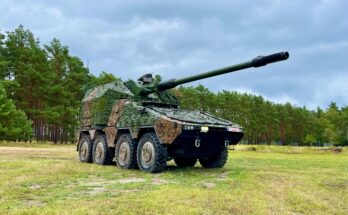
Gepard 1A2. Image – KMW
Loitering munitions are making a name for themselves in Ukraine. These weapons are taking a heavy toll on Russian and Ukrainian troops and equipment. Loitering munitions are changing warfare, at least until the air defenses of militaries catch up.
During the Second World War, as it lost control of the air over the battlefield, Germany began providing its military units with more and better self-propelled air defense systems, such as the Flakpanzer IV “Möbelwagen,” the Flakpanzer IV “Wirbelwind,” and the Flakpanzer IV “Ostwind.”
At the beginning of the war, the U.S. Navy’s fleet was woefully weak in anti-aircraft firepower. The Navy quickly moved to correct this problem, increasing the number of anti-aircraft weapons on its warships and replacing light guns with heavier models. At the end of the war, a destroyer had 42 barrels (3 5″/38 twins; three 40mm quads; 2 40mm twins; 10 20mm twins), a cruiser had 83 barrels (6 5″/38 twins; 12 40mm quads; 23 20mm singles), and a battleship had 165 barrels (10 5″/38 twins; 20 40mm quads; 49 20mm singles; and 8 20mm twins).
By the time of Okinawa, the U.S. Navy’s air defense capacity had increased substantially, as had the skills of its gunners.
Germany deployed a larger and larger number of anti-aircraft artillery systems to counter Allied bombers. The “flugabwehrkanone” is commonly referred to as “flak.” During the war, the German Luftwaffe’s flak arm eventually employed over one million people operating thousands of 88mm, 105mm, and 128mm guns deployed near potential targets or on recognized bomber routes.
The U.K. deployed 1,600 flak guns, including 40mm and 3.7-inch pieces, to defend against V-1 “Buzzbomb” attacks. At first, the defenders only brought down one out of every six incoming V-1s after expending an average of 2,500 shells. By August 1944, 60-80 percent of V-1s were downed with an average of 100 rounds.
The Allies quickly built an air defense network around Antwerp after its capture to defend the port city against V-1 attacks, bringing in mobile 90mm and 3.7-inch flak batteries. These guns stopped all but 5 percent of the V-1s from hitting their targets.
Now, a similar situation exists in Ukraine, which is enduring waves of Russian attack drones and missiles. The Ukrainian air defense network was unprepared to deal with these threats, but its Western allies are delivering surface-to-air missiles (SAMs) and ground-based air defense artillery, including mobile systems like the German-made Gepard. Slowly, the number of attack drones and missiles intercepted is rising. This is a battle of attrition. Who will run out of munitions first: the Ukrainian defenders or the Russian attackers?
Forecast International’s Unmanned Vehicles Forecast – Airborne Systems provides worldwide coverage of airborne unmanned vehicles, from the globe-trotting Global Hawk to the deadly Reaper, and covers the individual markets for reconnaissance UAVs and aerial targets. It also includes a section on the use of UAVs for civilian applications, ranging from environmental cleanup and forest monitoring to agricultural activity such as crop spraying and crop monitoring. Click here to learn more.
For more than 35 years, Larry has been involved in research and analytical work for various Forecast International projects. He has contributed to the Airborne Electronics Forecast and was chief editor on the World Aerospace Weekly newsletter. Larry was directly responsible for the creation of World Weapons Review, a biweekly industry market research publication specializing in weapon systems and related material. He was the creator of Unmanned Vehicles Forecast, launched to cover the growing market for civil and military drones, and was involved in the development of the Airborne Retrofit & Modernization Forecast service. He is currently responsible for the Missile Forecast and for FI's two Unmanned Vehicles Forecast services – Airborne Systems and Land & Sea Systems.




